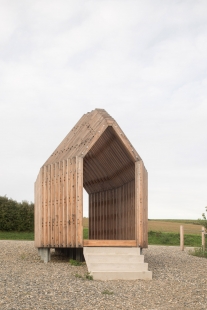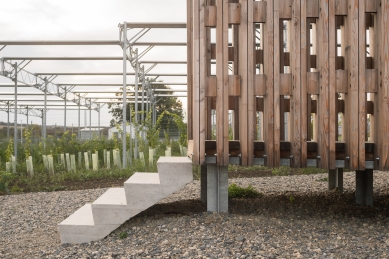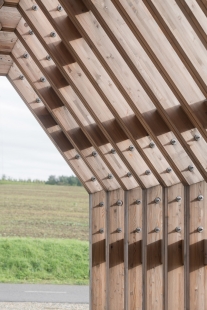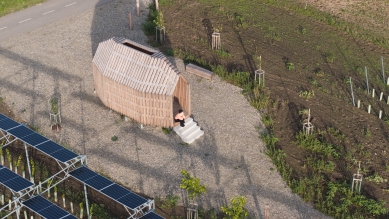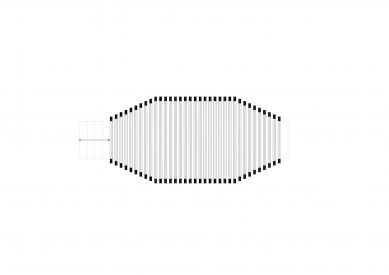
Chapel of Absolution

Chapel Among the Vineyards
In the South Moravian village of Starý Poddvorov, oil and natural gas were extracted until recently. The extraction company MND subsequently decided to rehabilitate the area and build what is known as agrovoltaics, or photovoltaic panels placed above newly planted vineyards. They invited the studio JUNG architekti to collaborate, which designed a facility in the form of a gazebo, which earned the nickname Chapel of Reflection due to its shape and function.
The land where the agrovoltaics are situated is located in the picturesque landscape of the Podluží region in Hodonín, specifically in an extraction area for oil and natural gas, where an extraction probe used to operate. After its decommissioning, the MND company decided to modify this area, which measures 65 × 28 meters, and build a renewable source of electric energy here.
MND reached out to architects Barbara and Adam Jung to create a public space for passersby and cyclists at this entirely technical structure, as the land lies close to a bike path leading from Dolní Bojanovice to Starý Poddvorov. The task was to design a bike gazebo that would differ in form from traditional shelters. By rationalizing complicated and sometimes even naive circular shapes, the authors of the design arrived at the shape of an octagon, reminiscent of the floor plan of a miniature temple nave. The architects also wanted the place to invite stopping, resting, and contemplation, which led to the birth of the name Chapel of Reflection.
At the same time, it was necessary to come up with a solution for the entire area, which the authors tentatively named Remízek, as it is nestled between two vineyards. The agrovoltaics are installed only on one of them to allow for a comparison of how the crops thrive. It is anticipated that the grapevines, which the agrovoltaic systems will protect from hail or excessive sunlight, should fare better. Whether this assumption is correct will later be proven by research from the Mendel University in Brno.
In the interest of preserving biodiversity, fruit trees and meadow lawns have also been planted here, and bee colonies and bumblebee nests have been installed.
From the very beginning, the authors were clear that the construction material for the building would be untreated wood. Specifically, they chose glued larch beams, connected by steel anchoring plates and dowels into two frames. To achieve the lightness and partial transparency of the gazebo, they designed the frames to be spaced apart. The principle of openness was enhanced by omitting the central parts of the frames at the ridge of the roof. This roof opening frames the view of the sky and indirectly refers to the purpose of the entire complex: the use of renewable energy sources. The object appears to levitate over a gentle slope, achieved by a steel structure mounted on foundation screws. This construction was chosen to ensure the stability of the entire building. Because the gazebo is passable and does not create an enclosed space, it resembles a gateway to another world.
A path made of gravel lawn will lead from the building towards the stream, along which benches made of solid larch wood, wooden bike racks, and information boards will be placed.
Living Soil
Revitalizing soil in agricultural landscapes is currently a highly debated and important topic, which the authors tried to reflect in their design. In the area, they proposed to plant fruit trees that, along with a diverse composition of herbs between the rows of vineyards, will prevent soil erosion during heavy rains. The trees will also provide shade for crops, shelter, and food for birds, and their root system will attract microorganisms that enrich the soil with nutrients.
First Agrovoltaics in the Czech Republic
Agrovoltaics is the installation of solar panels above or between crops on agricultural land. The goal of this method of installation is to avoid occupying valuable arable land with solar power plants. The panels in Starý Poddvorov are raised over the vineyard on narrow columns, ensuring that the structure occupies no more than one percent of the area of the land. For the MND company, given the lack of legislation, this is currently a demonstration pilot project that aims to pave the way for other similar installations…
In the South Moravian village of Starý Poddvorov, oil and natural gas were extracted until recently. The extraction company MND subsequently decided to rehabilitate the area and build what is known as agrovoltaics, or photovoltaic panels placed above newly planted vineyards. They invited the studio JUNG architekti to collaborate, which designed a facility in the form of a gazebo, which earned the nickname Chapel of Reflection due to its shape and function.
The land where the agrovoltaics are situated is located in the picturesque landscape of the Podluží region in Hodonín, specifically in an extraction area for oil and natural gas, where an extraction probe used to operate. After its decommissioning, the MND company decided to modify this area, which measures 65 × 28 meters, and build a renewable source of electric energy here.
MND reached out to architects Barbara and Adam Jung to create a public space for passersby and cyclists at this entirely technical structure, as the land lies close to a bike path leading from Dolní Bojanovice to Starý Poddvorov. The task was to design a bike gazebo that would differ in form from traditional shelters. By rationalizing complicated and sometimes even naive circular shapes, the authors of the design arrived at the shape of an octagon, reminiscent of the floor plan of a miniature temple nave. The architects also wanted the place to invite stopping, resting, and contemplation, which led to the birth of the name Chapel of Reflection.
At the same time, it was necessary to come up with a solution for the entire area, which the authors tentatively named Remízek, as it is nestled between two vineyards. The agrovoltaics are installed only on one of them to allow for a comparison of how the crops thrive. It is anticipated that the grapevines, which the agrovoltaic systems will protect from hail or excessive sunlight, should fare better. Whether this assumption is correct will later be proven by research from the Mendel University in Brno.
In the interest of preserving biodiversity, fruit trees and meadow lawns have also been planted here, and bee colonies and bumblebee nests have been installed.
From the very beginning, the authors were clear that the construction material for the building would be untreated wood. Specifically, they chose glued larch beams, connected by steel anchoring plates and dowels into two frames. To achieve the lightness and partial transparency of the gazebo, they designed the frames to be spaced apart. The principle of openness was enhanced by omitting the central parts of the frames at the ridge of the roof. This roof opening frames the view of the sky and indirectly refers to the purpose of the entire complex: the use of renewable energy sources. The object appears to levitate over a gentle slope, achieved by a steel structure mounted on foundation screws. This construction was chosen to ensure the stability of the entire building. Because the gazebo is passable and does not create an enclosed space, it resembles a gateway to another world.
A path made of gravel lawn will lead from the building towards the stream, along which benches made of solid larch wood, wooden bike racks, and information boards will be placed.
Living Soil
Revitalizing soil in agricultural landscapes is currently a highly debated and important topic, which the authors tried to reflect in their design. In the area, they proposed to plant fruit trees that, along with a diverse composition of herbs between the rows of vineyards, will prevent soil erosion during heavy rains. The trees will also provide shade for crops, shelter, and food for birds, and their root system will attract microorganisms that enrich the soil with nutrients.
First Agrovoltaics in the Czech Republic
Agrovoltaics is the installation of solar panels above or between crops on agricultural land. The goal of this method of installation is to avoid occupying valuable arable land with solar power plants. The panels in Starý Poddvorov are raised over the vineyard on narrow columns, ensuring that the structure occupies no more than one percent of the area of the land. For the MND company, given the lack of legislation, this is currently a demonstration pilot project that aims to pave the way for other similar installations…
JUNG architekti
The English translation is powered by AI tool. Switch to Czech to view the original text source.
0 comments
add comment






